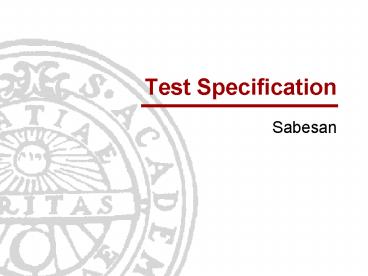Test Specification - PowerPoint PPT Presentation
Title:
Test Specification
Description:
Test Specification Sabesan Why test? Improve quality Find bugs (no crashes, erroneous calc) Verify the requirements? To put it another way: Testing is a verification ... – PowerPoint PPT presentation
Number of Views:130
Avg rating:3.0/5.0
Title: Test Specification
1
Test Specification
- Sabesan
2
Why test?
- Improve quality
- Find bugs (no crashes, erroneous calc)
- Verify the requirements?
- To put it another way
- Testing is a verification process to improve the
confidence that the system conforms to a
specification - Your job is to prove that the specification is
implemented correct
3
Fulfill requirements
- Think of how to test each requirement
- Some requirements should be considered in all
test cases (e.g. write to output file) - Others have specific tests
- Nothing unexpected (if spec. is not open)
4
Writing a test case
- Numbered
- Refers to requirement(s)
- Prove valid test case (against spec)
- Shows that all requirements are addressed (Suite)
- Tip A requirement that would have generated an
error earlier does not need to be mentioned over
and over again - Explains HOW to execute the test
- For dummies, include all required info
- Explains the in-parameters and the expected
output. - User (or script) able to determine the verdict
PASS or FAIL
5
Reference
- The purpose of the Test Specification is to
verify a system according to a referenced
Requirement Specification, i.e., add VERSION
number of the specification - Most of the formalism as RS
6
Test Specification A. Part 2 Test case A.1
Tested requirements - Req. A.3.10 ) (boundary
testing value inside the range) - Req. A.3.14
) (boundary testing value inside the range) -
Req. A.3.15 ) (boundary testing value inside
the range) - Req. A.1.27 ) mainly targeted
requirements for this test case Test data -
Change to a directory where you have write
permissions. For example cd / - Create a
simple XML-Input file containing a camera
(location0,0,0 sky0,1,0 look_at0,0,1)
and a red sphere (radius 1.2 location0,0,12
surfacepigmentcolor1,0,0) and name the file
simple_scene1.xml. - Write the following
command to the shell tracer -z 500 -x 500 -y 500
-w 1 -h 1 test_a1.ppm ltsimple_scene1.xml - Write
the following command to the shell to view the
output picture xview test_a1.ppm Expected
result - The program should terminate without
error message.
7
Tests for Non-Functional Req
- How to test a req. Code should be written in a
nice and structured way? - Refer to code review
- Verdict PASS if code review PASS
- If code not available write N/A not applicable
- This should be in the Test Plan (not in TS)
- How to test a req. Use getopt lib
- Query supplier e.g. ask developer/manager
- This is a simple YES/NO question
8
Testing limitations
- A crashed program is not an option.
- Parameter range e.g. if the specified range is
1..1000 this gives the tests - Inside range close to bound, i.e., 1 and1000
- Common or other value picked random inside the
range, e.g., 100 - Outside range close to bound, i.e., 0 and 1001
WHAT will happen here
9
Combinations
- You cannot test all cases, e.g., 100010001000
values - Vary upper and lower bound
- Vary object hidden each other (partly or fully)
- Vary object not in view of the camera
- You can discuss functionality with you MP2 group,
e.g., how the camera works or how the XML file
works, but NOT the test cases
10
Discussion
- Is it good to slim the test suite?
11
Equivalent tests
- For function f(x)
- Test f(0 if x0),(x if 0ltxlt10), and (0 if x10)
- If range for x is 0..10
- f(0) f(some in 1..9) f(10) must be tested
- Classes 0 1,...,910
- Is f() affected by something else?
- Can we suspect problems if something else changes?
12
Report
Test Verdict Comment
1 PASS
2 FAIL No error mess
13
Report
- Which system is tested (code version)
- Who has tested
- Which test specification used (version)
- RS































